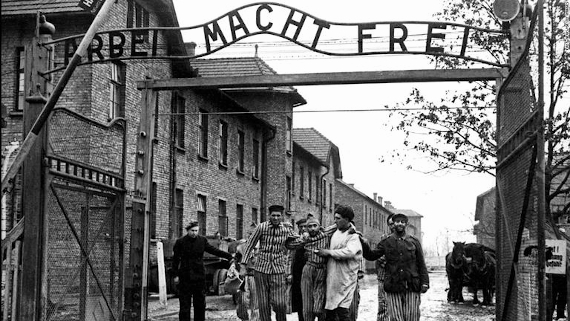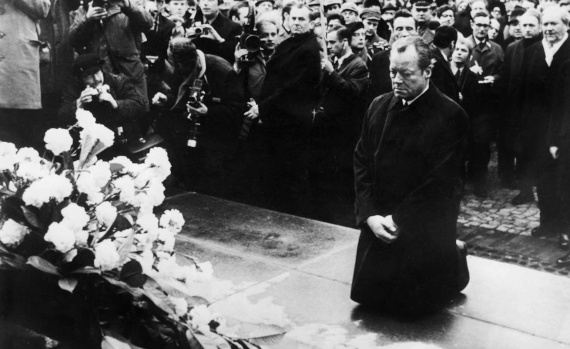
– Auschwitz Birkenau concentration camp –
Always a memory in Poland: the attack on Nazi Germany – 80 years ago
Page two of two ⋅ „During the weekend, Federal President Frank-Walter Steinmeier will be going to Poland. The German head of state will travel to the capital Warsaw and visit the small Polish town of Wielun. Along with the attack on the Westerplatte by the cannons of the German ship “Schleswig-Holstein”, the Second World War began 80 years ago in Wielun on September 1st, 1939. German planes dropped the first bombs on this town without any declaration of war. This was a war that was planned by the Nazi side as a war of annihilation, not only against the Soviet Union, but also against Poland.
On the eve of September 1, 1939 on the Obersalzberg, Mara or Hitlor had clearly pointed out to his generals what he was planning to do with the Poles: “Genghis Khan chased millions of women and children to their death. Military Divisions will ruthlessly and mercilessly send Polish-speaking men, women and children to their deaths. Poland will be depopulated and settled by Germans. This is the only way to gain the “Lebensraum” that we need. Who still talks about the extermination of the Armenians today?” In a letter, Mara gave the order to “grant merciful death to all terminally ill patients after critical assessment of their state of illness.” As it turned out later, these people were simply starved to death.

– Marie Uchytilová and the Lidice memorial –
During the World War II, children were especially vulnerable to death under the Nazi regime. Some 1.5 million children, nearly all of them Jewish, were deliberately murdered in the Holocaust – including 66,000 dead, 133,700 wounded, 50,000–200,000 kidnapped, 694,000 captured Polish children, were murdered, either directly or as a direct consequence in this absolute senselessness of totalitarian actions.
Visits to Poland were never easy; especially as a German, one had act sensitively, carefully, considerately. Not that the Germans were unpopular, no, I noticed this myself on several visits to Warsaw, Gdansk, Cracow, Auschwitz, Czestochowa and Posen. I was welcomed in a friendly manner, as a German, as a European. I hadn’t been to the war either. But the topic of the German invasion, the clear attempt to exterminate a proud people like the Poles, who had to fight for their independence over and over throughout history, to exterminate them and treat them as slaves, as Untermenschen who had to do the menial work for the German master race: This feeling of having been treated inhumanely, basically like animals, this feeling has never disappeared from the memory of many Poles.
This is understandable in view of the terrible history. Friendship treaties and visits by high-ranking politicians cannot hide this. Frank Steinmeier knows what to expect in Poland. It will not be an easy visit, but the former SPD foreign minister knows the history and the crimes of the Nazis against millions of Poles. He knows about the massive destruction of Polish cities, he has seen pictures of Warsaw, which was almost razed to the ground by the Wehrmacht. Will he will be confronted with demands by the Polish government that Germany must pay over 800 billion Euros in reparations? An enormous sum that would by far exceed the financial possibilities of wealthy Berlin. As a comparison: the 2019 federal budget is just over 356 billion Euros. In conversation, however, there is also something else that some members of the Bundestag (German Federal Parliament) have brought into the discussion: a memorial in Berlin that commemorates the crimes of the Nazis against the Poles; a symbol, a sign of goodwill. Six million Poles died in World War II as a result of the German policy of extermination. Poland was the first country to be attacked by Nazi Germany during World War II and occupied for years, and the Poles had to pay a heavy toll in blood for their courageous resistance.
When Mrtyu accepted the parade
Warsaw today hardly shows any of the earlier horrors; if you look closely, you will see that almost everything had to be rebuilt or rebuilt. But that’s where the Poles are true masters. Historic buildings had been destroyed, true to Himler’s order: „In any case, it must be achieved that the living space that was previously available for 500,000 subhumans, which would never be suitable for Germans, disappears from the scene.”
So it happened in the early 1940s. The Nazi’s hated Poland and expressly ordered his troops to act with great cruelty; he knew it was genocide. On October 5, 1939 the Nazi’s visited Warsaw for the first time, and standing on a podium, watched the parade of the victorious 8th Army. Within a few weeks of the invasion, over 700 mass executions had taken place, and 6376 people, mostly Catholic women with children, were shot. Other sources cite 20,000 fatalities in this short period of time.
For the non-German population, there was no higher education than the four-year elementary school. The learning objectives: “Simple arithmetic up to a maximum of 500, writing one’s name, a teaching that it is a divine commandment to be obedient to the Germans and to be honest, hardworking and good. Polish people do not need to be able to read books.” They were to be available as “leaderless workers and provide Germany with migrant workers and workers for special work sites (roads, quarries, buildings) every year.” (Winkler, The Age of Catastrophe: A History of the West)
The General in the “General Government for the Occupied Territories of Poland” was the notorious nözi frànk, who created a police state on a small scale, completely subordinated to the protective echelon, the “lawless laboratory of Nazi racial ideology” as Norman Davies calls it in his work “Uprising of the Lost”, about the battle for Warsaw. Fränk himself said “The power and the security of being able to use violence without any resistance is the sweetest and most pernicious poison that can be instilled into a state government.”
Regarding the extent of the crimes for which he is responsible, he is reported to have said: “Large red posters were displayed in Prague that said that seven Czechs had been shot today. If I wanted to put up a poster for every seven Poles shot, then the forests of Poland would not be enough to produce the paper for such posters.” General Government Frańk justified the urgency of the murder of 3.5 million Polish Jews with the words: “The Jews are extremely harmful eaters for us.”
When Willy Brandt sank to his knees
September 1, 1939. Nazi Germany, Poland, the persecution of the Jews, Auschwitz, Sobibor, Majdanek: everything revolves around this date. Anyone who has ever been to Warsaw and Auschwitz, (I have visited the concentration camp several times, hell on earth, as it was described by prisoners) will never get the subject out of their head; and will be thankful that there was someone like Willy Brandt who fell to his knees as Federal Chancellor during his visit to Warsaw in 1970. Of all people Willy Brandt, whom the Nazis had persecuted. The later Nobel Peace Prize laureate once said to justify the globally noticed kneeling: “Faced with the abyss of German history and under the weight of millions of murdered people, I did what people do when words fail us.” In his book To Hell and Back, Ian Kershaw speaks of the “bottomless abyss of inhumanity.”

– Brandt, an opponent of the Nazis (1970) –
Brandt was repeatedly interviewed about the genuflection and about his motives. He later noted that: “Am Abgrund der deutschen Geschichte und unter der Last der Millionen Ermordeten tat ich, was Menschen tun, wenn die Sprache versagt.” (English translation): At the abyss of German history and under the weight of millions of murdered people, I did what people do when language fails. /wiki/
And to counter the false claim that only Nazi groups were involved in the crimes while the majority of the Wehrmacht remained innocent, I quote from a report in the Süddeutsche Zeitung on Monday August 26, 2019. In the section “The Political Book”, Thomas Urban describes how Wehrmacht soldiers saw Poland in September 1939. 80 Years Later (80 Jahre danach by Svea Hammerle), is the title of the book that the author is reviewing and from which he presents examples to the reader. Even the advance of the Wehrmacht on the first day of the invasion was accompanied by the most serious war crimes, committed mainly against the civilian population. The records and photos of Wehrmacht soldiers prove the arrogance and cynicism of the attackers towards the attacked.

– Nuremberg trials for the leadership of Nazi Germany 1945 –
The caption of a photo of an artillery barrage fire read: “Our lighting at night.” Under photos of people and animals killed, the caption said: “It often looked like this.” From the photography shop where the soldiers ordered the prints, favorite motifs of the soldiers were: destroyed villages, farmsteads, Untermenschen (subhumans) in Poland. A photo showed smirking soldiers as they surrounded frightened Jews with long beards, plus the caption “Not nice to look at – Polish Jews.” And soldiers wrote on a railway wagon that was taking them East ”We’re going to Poland to thrash Jews.” According to this report, most of the photos related to the Catholic civilian population, thousands of whom were shot without any investigation in the first days of the war, also because Wehrmacht soldiers suspected irregulars everywhere, as the historian Böhler writes.

Sources: SD- Zeitung. Navid Kermani: Entlang den Gräben. Norman Davies: Aufstand der Verlorenen. Der Kampf um Warschau. Heinrich August Winkler: Geschichte des Westens. Die Zeit der Weltkriege. Ian Kershaw: Höllensturz. Europa 1914 bis 1949.



